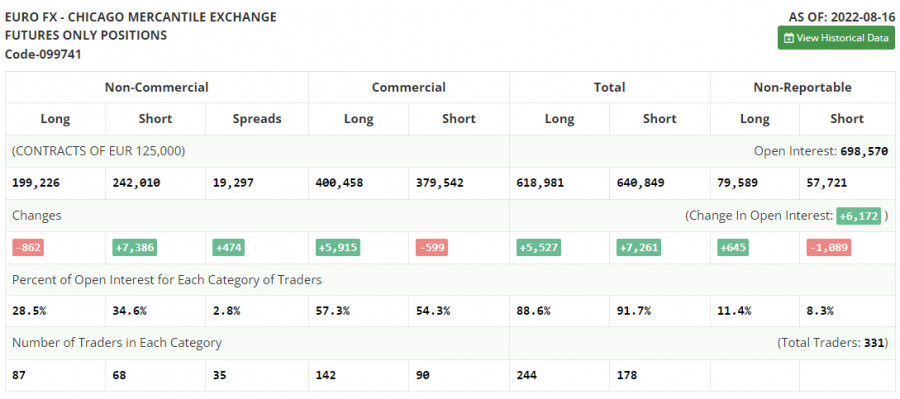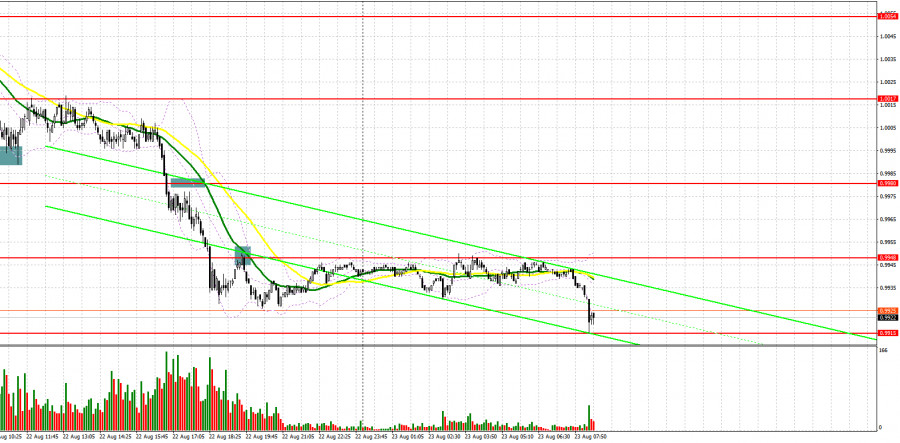
When to go long on EUR/USD:
Several excellent market entry signals were formed yesterday. I suggest you take a look at the 5-minute chart and figure out what happened. I paid attention to the 1.0000 level in my morning forecast and advised you to make decisions on entering the market from it. We did not have to wait long for a new wave of decline from the euro. As a result of the breakdown of 1.0026, I did not wait for a signal to enter the market, so the emphasis shifted to the level of 1.0000. A false breakout there resulted in an excellent entry point, but the euro did not rapidly rise. After correcting upwards by 17 points, the price returned to parity again. The bears quickly coped with 0.9980 in the afternoon, but there was no reverse test from the bottom up, as well as a sell signal. Only after the breakthrough and update of 0.9948 was it possible to receive a signal to enter the market, which brought about 20 points of profit.

COT report:
Before talking about the further prospects for the EUR/USD movement, let's look at what happened in the futures market and how the Commitment of Traders positions have changed. The Commitment of Traders (COT) report for August 16 logged a sharp growth in short positions and a decline in long positions, which confirms the euro's current position against the US dollar. The risk of a looming recession in the US is now combined with the risk of more serious problems in the eurozone, which will begin this autumn amid a sharp rise in energy prices and further inflation, which the European Central Bank is fighting at a fairly moderate pace so far. At the end of this month, American politicians will have a meeting at Jackson Hole, where the key word will be Federal Reserve Chairman Jerome Powell. The pair's succeeding direction will depend on this, as a strong dollar harms the American economy and further accelerates inflation, which the central bank is fighting against. The COT report indicated that long non-commercial positions decreased by 862 to 199,226, while short non-commercial positions jumped by 7,386 to 242,010. At the end of the week, the total non-commercial net position remained negative and fell to -42,784 against -34 536, which indicates that the euro could be under pressure again and may also fall further. The weekly closing price decreased and amounted to 1.0191 against 1.0233.

Today we expect quite a large number of fundamental statistics on the euro area, which could further harm the prospects of the euro. The index of business activity in the manufacturing sector, the services sector and the eurozone composite PMI index - all these indicators are unlikely to show good numbers, so do not expect anything good. The indicator of consumer confidence will also add to the negative picture, which should decrease even more, reflecting the mood of consumers and their attitude towards the current situation with the economy. In case the pair falls further, forming a false breakout in the area of the nearest support at 0.9913 will be the reason for opening long positions. This requires good indicators of activity in the euro area in August this year. In this case, we could count on building a correction and updating the resistance at 0.9948. A breakthrough and test from the bottom of this range will allow you to get out of the bearish pressure, which will hit the stops, creating another signal to enter longs with the possibility of a larger move up to 0.9980, where the moving averages play on the bears' side. The farthest target will be the area of 1.0017, where I recommend taking profits.
If the EUR/USD declines and there are no bulls at 0.9913, the pressure on the pair will increase, which will lead to another annual low at 0.9886. I also recommend buying only on a false breakout from this level. I advise you to open long positions on EUR/USD immediately for a rebound only from 0.9861, or even lower - in the area of 0.9830, counting on an upward correction of 30-35 points within the day.
When to go short on EUR/USD:
Yesterday, bears achieved new lows and blew the pair below parity. It is obvious that no one is going to leave the market and slow down even before an important meeting of the Fed bankers. A good option for short positions is a false breakout in the nearest resistance area of 0.9948, growth to which can occur only after the release of a number of good fundamental statistics on the eurozone. All this can push the euro to move down to the area of 0.9913, although there is already quite a bit before its update. A breakdown and consolidation below 0.9913, as well as a reverse test from the bottom up - all this creates another sell signal with the removal of bulls' stop orders and a larger movement of the pair to the 0.9886 area. Consolidating below this area is a direct road to 0.9861, where I recommend completely leaving short positions. A more distant target will be the area of 0.9830.
In case EUR/USD moves up during the European session, as well as the absence of bears at 0.9948, we can expect a bigger push for the pair. Then I advise you to postpone shorts until 0.9980. Forming a false breakout there will be a new starting point for entering short positions. You can sell EUR/USD immediately for a rebound from the high of 1.0017, or even higher - from 1.0054, counting on a downward correction of 30-35 points.
Indicator signals:
Moving averages
Trading is conducted below 30 and 50 moving averages, which indicates the bears' advantage.
Note: The period and prices of moving averages are considered by the author on the H1 hourly chart and differs from the general definition of the classic daily moving averages on the daily D1 chart.
Bollinger Bands
A breakthrough of the lower border of the indicator in the area of 0.9886 will lead to a fall in the euro. Surpassing the upper border of the indicator in the area of 0.9980 will lead to the growth of the euro.
Description of indicators
Moving average (moving average, determines the current trend by smoothing out volatility and noise). Period 50. It is marked in yellow on the chart.Moving average (moving average, determines the current trend by smoothing out volatility and noise). Period 30. It is marked in green on the chart.MACD indicator (Moving Average Convergence/Divergence — convergence/divergence of moving averages) Quick EMA period 12. Slow EMA period to 26. SMA period 9Bollinger Bands (Bollinger Bands). Period 20 Non-commercial speculative traders, such as individual traders, hedge funds, and large institutions that use the futures market for speculative purposes and meet certain requirements.Long non-commercial positions represent the total long open position of non-commercial traders.Short non-commercial positions represent the total short open position of non-commercial traders.Total non-commercial net position is the difference between short and long positions of non-commercial traders.